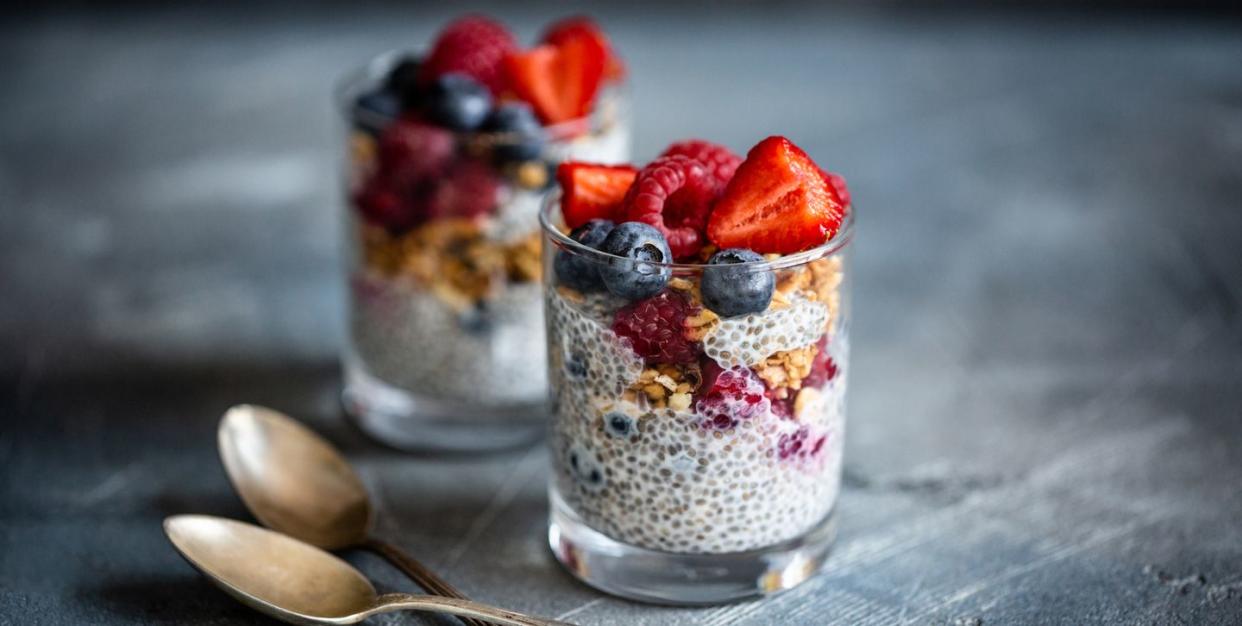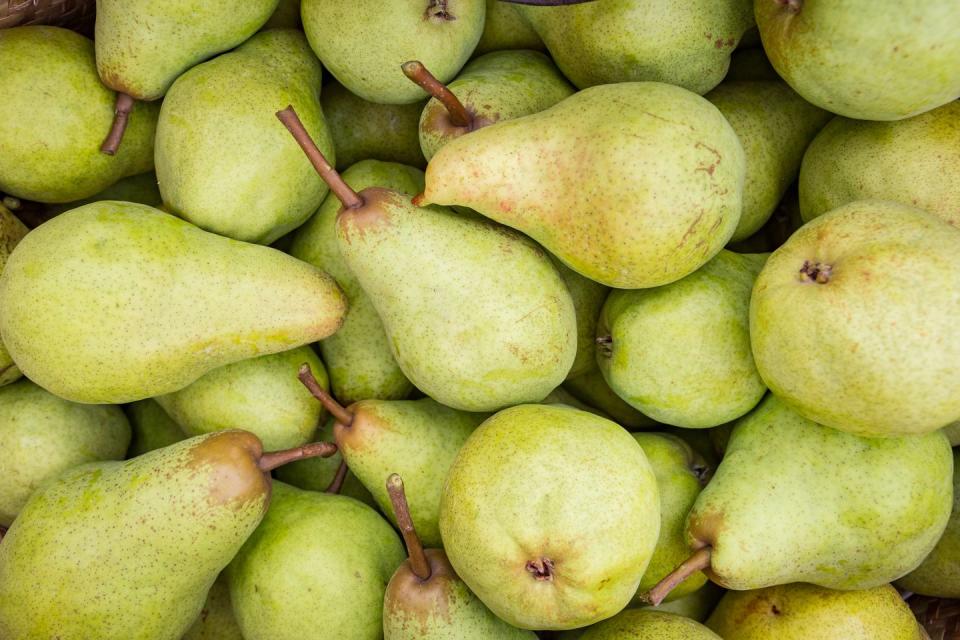How Fiber Can Help You Lose Weight (Including Stubborn Belly Fat)

"Hearst Magazines and Yahoo may earn commission or revenue on some items through these links."
Fiber may not be as trendy a term as keto, paleo, or flexitarian—hey, it makes us think of bran muffins and carpet fibers, too!—but let's give that five-letter word a little love. After all, you can use fiber for weight loss. (One large study published last year in the Journal of Nutrition found that increased fiber intake helped subjects lose weight independently of other factors in their diet; a 2018 study in Nutrition found that when subjects focused simply on increasing the amount of fiber and lean protein in their diet, they ate few calories and lost weight as a result,)
“Fiber slows the speed of digestion, which makes you feel full and may help you eat less and stay satisfied longer,” explains Marisa Moore, R.D.N., L.D., a culinary and integrative dietitian. When you feel full after your meal, you’re less likely you reach for a bag of chips or cookies an hour later, adds Krista Linares, R.D.N., who specializes in diabetes management and prevention in the Latino community.
In addition to making you feel full, fiber plays another important role in weight loss: “Because fiber helps slow down digestion, it also slows down how quickly your body responds to the carbohydrates you eat, and can help you better manage your insulin and blood sugar response to food,” says Linares.
Fiber is also crucial for digestive and heart health. “Fiber is not digestible, so that extra bulk is added to your stool, which helps you stay regular,” explains Linares. “Having healthy, regular digestion can have long term health benefits such as reducing the risk of colorectal cancers.” It also keeps your heart healthy by lowering blood pressure, and helping reduce LDL cholesterol, Linares adds.
What is fiber, exactly?
Simply put, fiber is the part of a plant that your body can't digest (unlike fats, proteins, and carbohydrates, which your digestion system breaks down and absorbs). There are two kinds of fiber, Moore explains: "Soluble fibers hold water and tend to help slow down digestion, while insoluble fiber is key for regularity." You can find soluble fiber in food such as apples, carrots, peas, beans, and oats. Good sources of insoluble fiber include wheat bran, nuts, cauliflower, brown rice, lentils, and celery.
So how much fiber should I eat?
Adult women should consumer at least 25g of fiber a day, though Moore and Linares both warn that you should up your fiber game slowly—if you go from zero to 25 overnight, you may experience gastrointestinal issues. Linares recommends adding one extra serving a day (about 5g), and getting used to that for a few days before adding in another serving. “If the you eat 3 meals and 2 snacks a day, you should aim to eventually get about 5 grams of fiber at every meal or snack,” she says.

Which foods are high in fiber?
“There are so many great options for adding fiber,” says Moore, who lists berries, beans, peas, and lentils as her favorite fiber-rich foods. “When fresh berries are in season, enjoy them fresh, tossed into salads, as a snack, or in yogurt. And be sure to stock frozen berries for a quick and nutritious addition to smoothies,” she suggests. Linares is a big fan of pistachios, which have 3g fiber in 1 ounce. Here is a list of top tastes to choose from:
Chia seeds (2T): 10g
Black beans (1/2 cup): 8.3g
Chickpeas (½ cup): 8.1g
Lentils (1/2 cup): 7.8g
White beans (1/2 cup): 6.3g
Pears: 5.5g
Avocado (1/2 cup): 5g
Edamame (1 cup) 5g
Almonds (1/4 cup): 4.5g
Apples: 4.4g
Bulgur (1/2 cup): 4.1g
Raspberries (1/2 cup): 4g
Collard greens (1 cup): 4g
Blackberries (1/2 cup): 3.8g
Baked potato: 3.6g
Peas (1/2 cup): 3.5g
Popcorn (3 cups): 3.5g
Whole grain bread (1 slice): 3g
Strawberries (1 cup): 3g
Quinoa (1/2 cup): 2.6g
Broccoli (1 cup): 2.4g
Kiwi: 2.1g
Blueberries (1/2 cup): 2g
Pros of using fiber for weight loss
There are a few different reasons to use fiber for weight loss. Those can include:
It helps fill you up. “Fiber is really important for satiety—it helps us feel full,” says Jessica Cording, M.S., R.D., author of The Little Book of Game-Changers: 50 Healthy Habits For Managing Stress & Anxiety. “That’s really important for curbing compulsive snacking.” When you add more fiber to your diet, “you are less likely to be hungry so soon after eating,” says nutritionist Keri Gans, R.D., author of The Small Change Diet.
It helps slow down digestion. Fiber takes up more space in your stomach than many other nutrients, Cording says. As a result, “it helps you stay fuller, longer,” she says.
It helps keep your blood sugar in check. Fiber is “really good” at regulating your blood sugar, Cording says. That can help prevent blood sugar crashes, which can make you feel cranky, she says.
Cons of using fiber for weight loss
While fiber is important for your health, there are some downsides to using it for weight loss.
It can make you gassy and bloated. “If your body isn’t used to you consuming fiber, then it may cause side effects such as gassiness and bloating,” Gans says. But, she adds, “if you gradually add fiber to your diet and make sure to drink plenty of water, that should help decrease your chances for negative side effects.”
It can mess with your ability to absorb certain nutrients. If you’re having a typical recommended fiber intake—i.e. 25 grams a day for women and 38 daily grams for men, per the Academy of Nutrition and Dietetics—you should be just fine, Cording says. “But some diets call for very high amounts of fiber—50 grams or more,” she points out. “Too much fiber can impair absorption of certain nutrients, including calcium.”
How to determine how much fiber you need to lose weight
There’s no magic number here, but Gans recommends trying to get the daily recommended amount of fiber (again, 25 grams a day for women and 38 daily grams for men) and seeing how you do. “You should be focusing overall on adding more carbohydrates, such as 100% whole grains, fruits, veggies, and legumes, that are good sources of fiber,” she says.
How to use fiber as part of a greater weight loss plan
Fiber for weight loss works best as a greater weight loss plan. Meaning, you shouldn’t just rely on fiber to help you lose weight. Cording’s recommendation: Incorporate one high-fiber food into each meal instead of trying to jam in a bunch of fiber at one time. “Fiber can help you feel full and, when you feel full, it can be very helpful toward staying on track with healthy eating habits,” she says.
And don't forget to add water!
Any time you add fiber to your routine, you must make sure you're drinking plenty of water, says Linares: “One of the ways fiber works is by drawing water into your stool, which helps keep you regular. This only works if you drink enough water, though." She suggests adding an extra glass of water to your routine as you build up your fiber intake.
You Might Also Like

